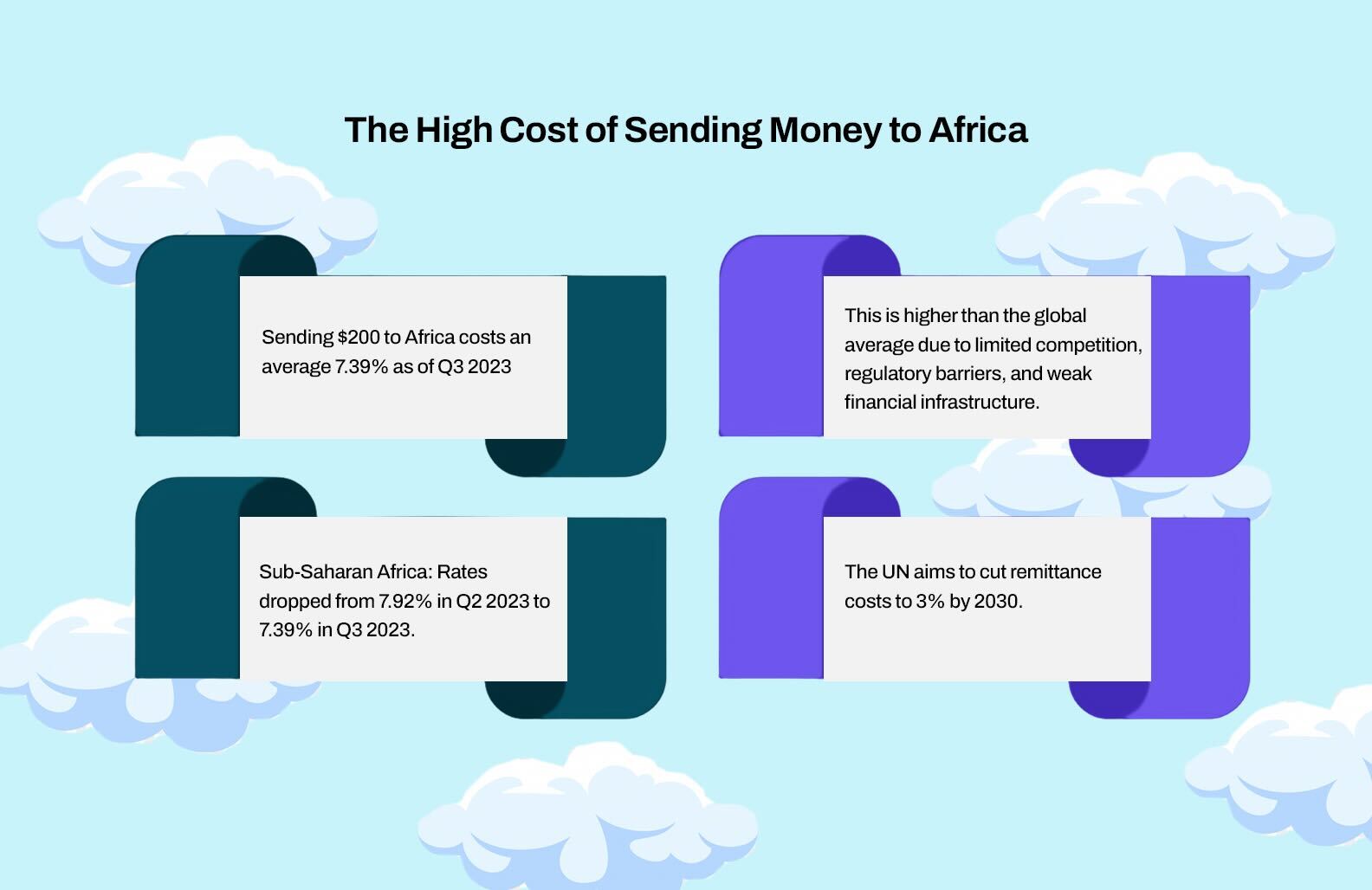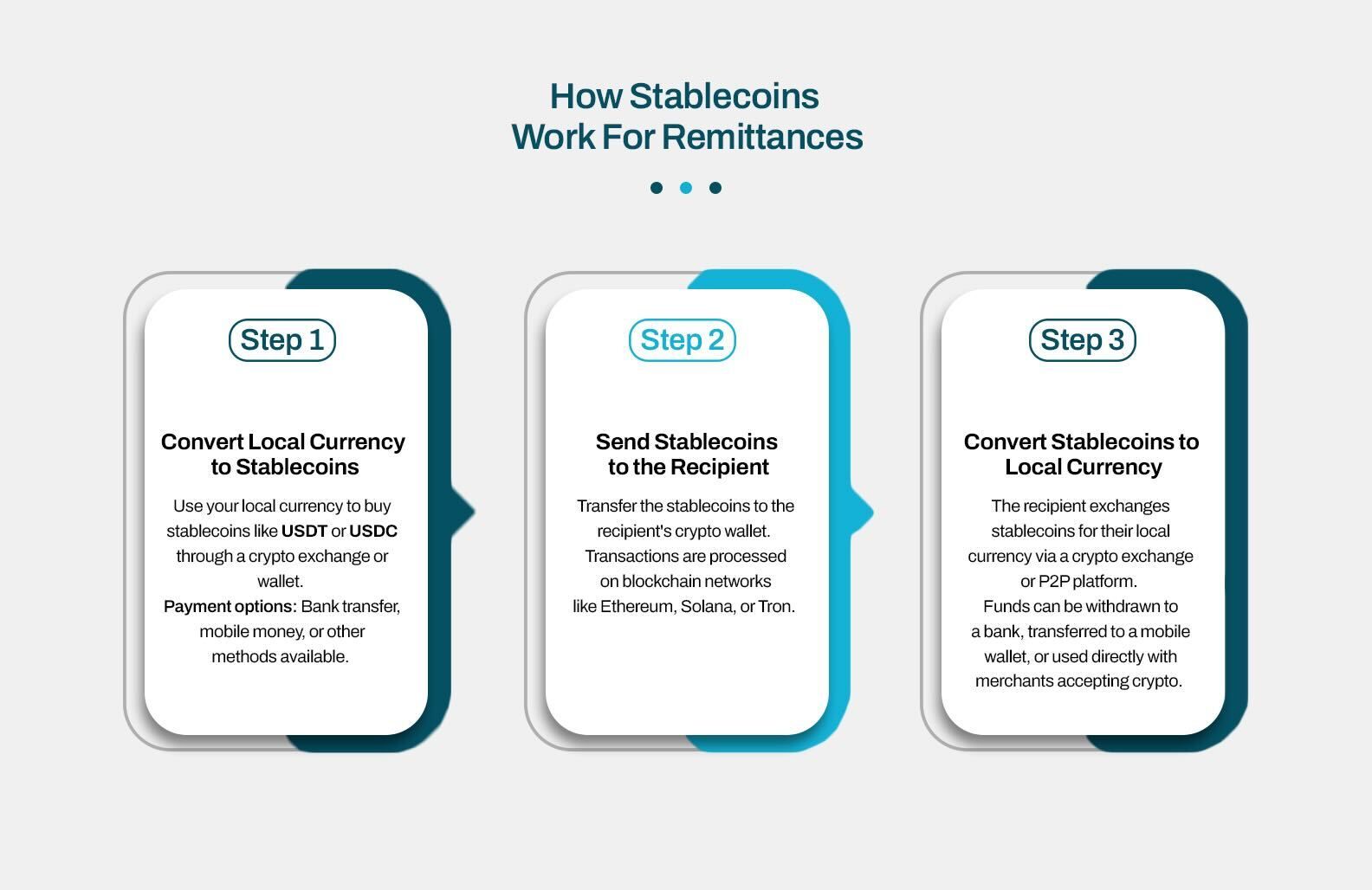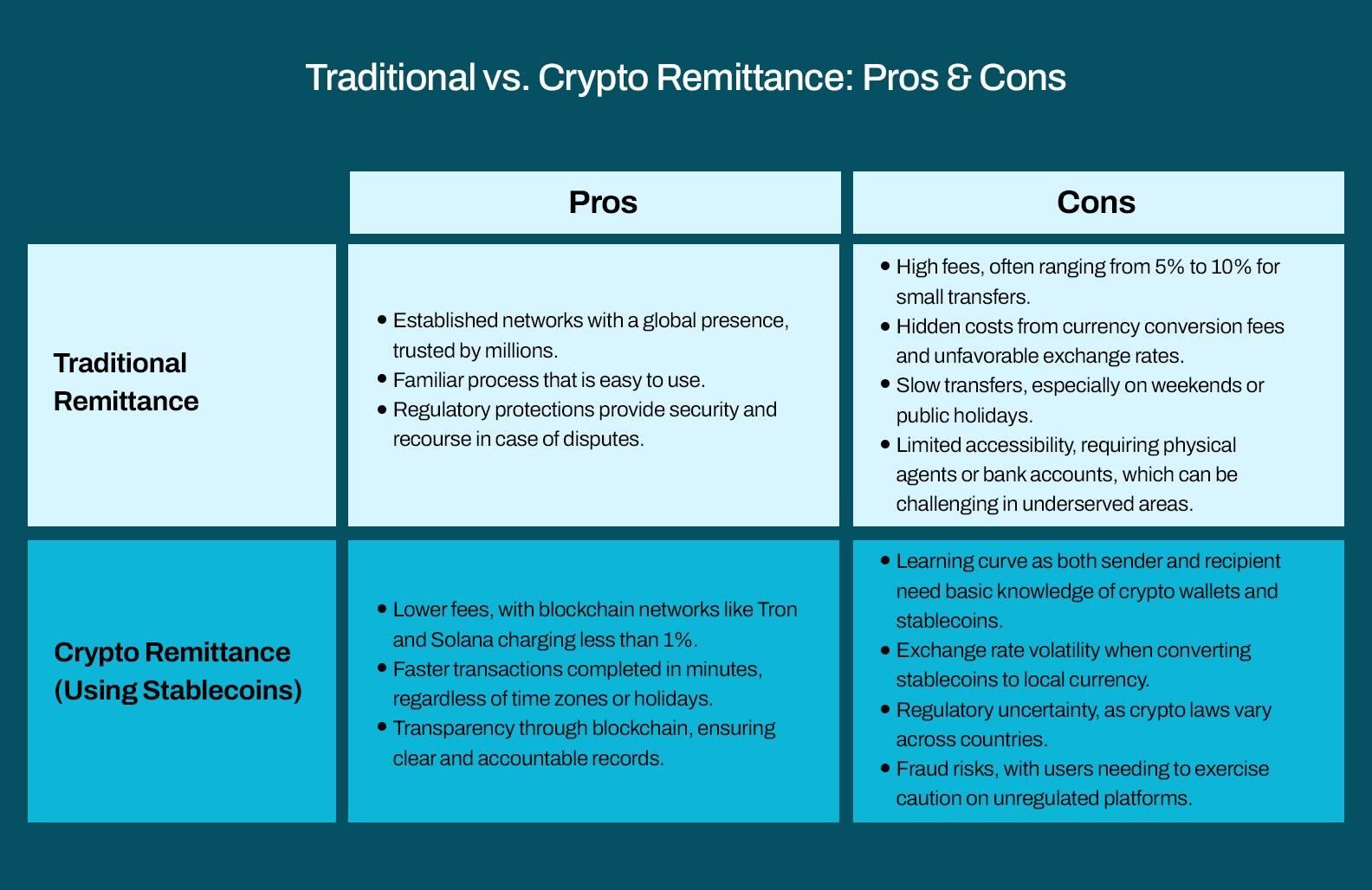Crypto as a solution for African remittance problems
Can Crypto Solve the Challenge of Sending Money Home?
Key Definitions to Note:
Cryptocurrency (also known as crypto): Cryptocurrency is a digital asset that exists in the form of coins and tokens. It can be accessed from anywhere in the world at any time. It is used for online trading and payments and as a store of value. The most popular cryptocurrency is Bitcoin. Other popular cryptocurrencies include Ethereum (ETH), Solana (SOL), Cardano (ADA), and Tether (USDT).
Blockchain: A blockchain is a database or, as it’s uncommonly called, distributed ledger technology. It is like a digital notebook that keeps a permanent record of transactions. Blockchains are used for financial transactions, securing identities, and more.
Remittance: A remittance is a sum of money sent to another party, usually in another country.
Fiat Currency/Money: Fiat money is a currency issued and backed by the government rather than being backed by a physical commodity such as gold or silver. It is typically seen as the opposite of cryptocurrency. Fiat currencies include Dollar, Naira, Pounds, Cedis, Euros, Rand, Rupees, Francs, and so on.
In 2023, Africa received $100 billion in remittances, equaling nearly 6 per cent of the continent's Gross Domestic Product (GDP).
This means at least 20 million people were sending money to fathers, mothers, siblings, partners, and business partners, making donations, thus contributing directly to household incomes and local economies.
Gross Domestic Product (GDP) is the total value of goods and services produced in a region. Remittances equaling 6% of Africa's GDP means that this external financial inflow is a significant component of the continent's overall economic activity.
Remittances are a tale as old as migration itself.
These transactions are often made by migrant workers sending money to support their loved ones back home.
Remittances serve as a crucial lifeline for countless families across the globe.
To send money back home, you typically need funds in the currency of your current country—such as dollars, pounds, or euros—an internet connection, and a platform to facilitate the transfer.
These platforms allow you to convert your money to the local currency before sending it or sending the funds in the original currency.
The most popular options are traditional services like MoneyGram and Western Union or mobile remittance apps.
Remittance apps fall into two categories: fiat-based and cryptocurrency-based. While fiat apps remain the standard, crypto-based apps are rapidly gaining traction.
As of 2024, Nigeria and South Africa lead the world in cryptocurrency ownership, according to a 2024 report by blockchain software firm ConsenSys and research company YouGov.
A key driver of crypto adoption in Africa is the use of stablecoins, especially USDT, along with other locally pegged tokens such as XAF, GHS, and NGNX.

How Remittance Works with Crypto Stablecoins
Stablecoins are cryptocurrencies pegged to stable assets like the US Dollar (e.g., USDT, USDC) or other fiat currencies.
They maintain a consistent value, making them ideal for transferring money without worrying (too much) about price volatility.
Here's a step-by-step breakdown of the remittance process using stablecoins:
Step 1: Convert Your Local Currency to Stablecoins
Start by using your local currency to buy stablecoins like USDT or USDC on a crypto exchange or wallet.
You can do this through a bank transfer, mobile money, or other payment methods available to you.
Step 2: Send Stablecoins to the Recipient
Transfer the stablecoins directly to the recipient's crypto wallet.
These transactions are processed on blockchain networks such as Ethereum, Solana, or Tron.
Step 3: Convert Stablecoins to Local Currency
The recipient then converts the stablecoins to their local currency using a crypto exchange or a peer-to-peer platform.
They can withdraw the funds to a bank account, transfer them to a mobile wallet, or use the crypto directly for purchases if local merchants accept it.

The cost of Traditional remittance vs The cost of Crypto remittance
Remittances play a crucial role in Africa's economy, but sending money to the continent is still expensive, averaging 7.39% of a $200 transfer in Q3 2023.
This is higher than the global average due to limited competition, regulatory issues, and weak financial infrastructure.
The UN aims to cut remittance costs to 3% by 2030, and progress is being made, with costs gradually declining, such as in Sub-Saharan Africa, where rates dropped from 7.92% in Q2 2023 to 7.39% in Q3 2023.
The 2024 IDFR theme, "Digital remittances towards financial inclusion and cost reduction," emphasised the potential of digital remittances to make money transfers cheaper and easier while addressing the challenges they face.
Digital remittance costs remain significant, averaging 5% in 2023, though they are lower in regions like West Africa (~3%). Solutions like blockchain, automation, and fewer intermediaries can help reduce these costs further.
Mobile money has become the most affordable way to send and receive funds, thanks to user-friendly apps that work on basic smartphones.
Pros and Cons of Traditional Remittance vs. Crypto Remittance

When it comes to sending money across borders, both traditional remittance methods and crypto remittance via stablecoins have distinct costs, benefits, and drawbacks.
Here's a comparison to help understand the key differences:
Traditional Remittance: Pros and Cons
Pros:
- Established Networks: Services like Western Union and MoneyGram have global reach and are trusted by millions.
- Familiar Process: Many people already know how to use these systems, and they offer customer support for guidance.
- Local Currency Payouts: Funds can be collected in the recipient's local currency without additional steps, especially when using mobile apps.
- Regulatory Protections: Transactions are overseen by financial authorities, ensuring security and recourse in disputes.
Cons:
- High Fees: Fees can range from 5% to 10% of the transaction amount, especially for small transfers.
- Hidden Costs: Currency conversion fees and unfavourable exchange rates add to the overall expense.
- Slow Transfers: Transactions can take days, especially if sent over weekends or holidays.
- Limited Accessibility: Requires physical access to agents or bank accounts, which can be a barrier in underserved areas.
Crypto Remittance (Using Stablecoins): Pros and Cons
Pros:
- Lower Fees: Blockchain networks like Tron and Solana charge minimal transaction fees, often less than 1%.
- Faster Transactions: Transfers are completed within minutes, regardless of time zones or holidays.
- Transparency: Blockchain records every transaction, ensuring clarity and accountability.
- Accessibility: With just a smartphone and internet access, users can send and receive funds without relying on banks.
Cons:
- Learning Curve: Both sender and recipient need basic knowledge of crypto wallets and stablecoins.
- Volatility in Exchange Rates: While stablecoins are pegged to fiat, converting them to local currency may involve fluctuating exchange rates.
- Regulatory Uncertainty: Crypto regulations vary widely, potentially limiting access in some countries.
- Fraud Risks: Lack of regulation can expose users to scams if they're not careful about the platforms they use.
Can Crypto Solve the Challenge of Sending Money Home?
Yes and No.
Let's break down our answers into the helpful and the challenging aspects of using cryptocurrency for remittances to Africa.
Or, in simpler terms, let’s break down how cryptocurrency makes it easier for people outside Africa to send money home, how it helps those back home receive it, and the challenges involved in the process
The Helpful
- Lower Transaction Costs: Traditional remittance services often charge high fees for sending money home, averaging 7.39% in Africa. Cryptocurrencies like Bitcoin or stablecoins such as USDT can significantly reduce these costs by cutting out intermediaries like banks and money transfer operators. Blockchain transactions often have minimal fees, making it a cost-effective option.
- Faster Transfers: Sending money through traditional channels can take days, especially for cross-border transactions. Crypto enables near-instant transfers, allowing families to receive funds quickly, even during emergencies.
- Borderless Access: Cryptocurrencies aren't restricted by national borders, making them ideal for people living in regions with limited access to banking infrastructure. All that's needed is a smartphone and internet connection, which are increasingly accessible across Africa.
- Transparency and Security: Blockchain technology ensures that transactions are secure and transparent, reducing fraud risks and increasing trust between senders and recipients.
The Challenging
- Volatility Risks: Most cryptocurrencies are highly volatile. While stablecoins aim to solve this by pegging their value to fiat currencies, other cryptos like Bitcoin can lose or gain significant value in a short time, posing risks for users relying on stable remittance amounts.
- Adoption Barriers: Many people in rural areas lack the technical knowledge to use cryptocurrencies effectively. Education and user-friendly platforms are crucial but often lacking in many parts of Africa.
- Regulatory Challenges: Governments worldwide are still figuring out how to regulate cryptocurrencies. In some African countries, crypto usage is restricted or heavily taxed, which can deter adoption for remittances.
- Access to Cash-Out Options: While receiving crypto is easy, cashing out into local currencies can be a challenge, especially in areas without established crypto-to-fiat services. This adds an extra step and potential cost for recipients.
- Scams and Security Risks: While blockchain technology itself is secure, the crypto space is rife with scams, fraudulent platforms, and phishing attacks, making it a risky option for less tech-savvy users.
Looking Forward: Crypto as an Undeniable Way of Remittance for Africa
Cryptocurrency is steadily carving out its place as a viable solution for remittances in Africa.
Despite existing challenges, its potential to transform how money is sent across borders is undeniable.
Here's what the future could hold for crypto remittances on the continent.
- As crypto adoption grows and blockchain technologies evolve, transaction costs are expected to drop even further. This will make cryptocurrencies a cheaper alternative to traditional remittance methods, aligning with the UN's Sustainable Development Goal of reducing remittance fees to 3% by 2030.
- The growth of crypto-based remittance platforms can lead to increased competition, forcing traditional providers to lower their fees. As these platforms expand their reach and improve user experience, sending and receiving money will become easier and more affordable. This is particularly important for African migrants who rely on remittances to support their families and communities back home.
- Another promising aspect is the potential of stablecoins to address volatility concerns. Cryptocurrencies like Bitcoin and Ethereum can experience significant price swings, but stablecoins pegged to fiat currencies like the US dollar, offer a stable value for cross-border transactions. As stablecoins become more widely used, they can provide a safer and more predictable way for individuals to send and receive money, further driving adoption across Africa.
- Collaboration between crypto platforms and local financial institutions will also likely play a crucial role. Cryptocurrency companies can integrate their services into existing financial ecosystems by partnering with banks, microfinance organisations, and mobile money operators. This hybrid approach can help overcome trust issues and create a better experience for users, allowing them to transition between crypto and fiat currencies easily.
While challenges such as regulation, education, and infrastructure remain, the momentum behind crypto remittances in Africa is undeniable.
The combination of cost efficiency, accessibility, and technological innovation makes it a powerful tool for addressing the remittance challenges faced by millions.
As adoption grows and ecosystems mature, cryptocurrency could redefine how money moves across borders.
Disclaimer: This article was written to provide guidance and understanding. It is not an exhaustive article and should not be taken as financial advice. Obiex will not be held liable for your investment decisions.


